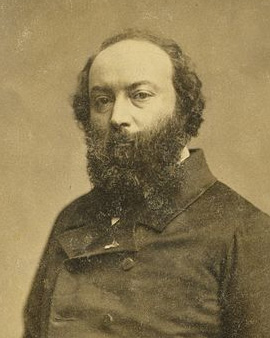Secluded forests, quiet clearings, undisturbed nature... What we long for became a rarity in the Parisian countryside as early as the mid-19th century. The forest of Fontainebleau had been a refuge for kings since the Middle Ages, but industrialisation put it under increasing threat. It was discovered just in time by the plein-air painters who brought their magnificent natural landscapes to the canvas on the spot, trying to capture the play of light, the rustling of the leaves and the pride of the mighty giant trees with a brush.
Pierre Etienne Théodore Rousseau, born in 1812, was one of the first to paint this ancient forest. The son of a Paris tailor, he took lessons from his painting cousin at an early age. However, he was not interested in history painting, which was very popular at the time. He soon left the studio of his highly respected teacher, and both the subjects and the painting technique seemed too artificial and too bloodless to him. Instead, Rousseau wanted to capture real life and true nature with all his senses. His first study trips took him to Normandy and Auvergne, and what he found there he hoped to track down near his home town. At the age of 20, Rousseau took canvas, paints, brushes and easel with him for the first time to the forest of Fontainebleau, which was only 50 kilometres south of Paris. There, he did not only want to draw from nature or make small-format oil sketches, but also to create fully valid paintings of the gnarled oaks, majestic pines, but also of the shapely sandstone rocks that have always captured people's imagination. In this way he created the genre of the Paysage Intime, the "familiar landscape", which was not distinguished by being spectacular, but by its simple beauty.
His paintings had little success in the Paris Salon at first, but gradually they were noticed in the art world. The first painter colleagues joined him in the 1830s, and their names still have a big sound today: Jean-Francois Millet, Charles-Francois Daubigny or even Camille Corot. From the interaction of these artist individuals, who rejected the academic way of painting and instead sought an immediate access to nature, the School of Barbizon was born, named after a village in the forest of Fontainebleau. Rousseau left the big city behind him more and more often and finally moved here completely with his wife in 1848. Strictly speaking, however, it is not a school, but a training of the individual's understanding of art in direct dialogue with the surrounding nature. It is also thanks to the artists' colony of Barbizon that the forest of Fontainebleau was declared the first French nature reserve and is still preserved today. Theodore Rousseau died in 1867 at the age of 55 in Barbizon, surrounded by his beloved nature, whose facets and transformations he had painted incessantly. What followed a little later was Impressionism.
×





.jpg)
.jpg)
.jpg)
.jpg)
.jpg)
.jpg)
.jpg)
.jpg)
_-_(MeisterDrucke-969941).jpg)
_-_(MeisterDrucke-969941).jpg)
_19th_century_Barb_-_(MeisterDrucke-1030108).jpg)
_19th_century_Barb_-_(MeisterDrucke-1030108).jpg)
.jpg)
.jpg)
.jpg)
.jpg)
.jpg)
.jpg)
.jpg)
.jpg)
.jpg)
.jpg)
.jpg)
.jpg)
.jpg)
.jpg)
.jpg)
.jpg)
.jpg)
.jpg)
.jpg)
.jpg)
.jpg)
.jpg)
.jpg)
.jpg)
.jpg)
.jpg)
.jpg)
.jpg)
.jpg)
.jpg)
 - (MeisterDrucke-253451).jpg)
 - (MeisterDrucke-253451).jpg)
.jpg)
.jpg)
_-_(MeisterDrucke-903600).jpg)
_-_(MeisterDrucke-903600).jpg)
.jpg)
.jpg)
.jpg)
.jpg)
.jpg)
.jpg)
.jpg)
.jpg)
.jpg)
.jpg)
.jpg)
.jpg)
.jpg)
.jpg)
.jpg)
.jpg)
_-_(MeisterDrucke-903616).jpg)
_-_(MeisterDrucke-903616).jpg)
.jpg)
.jpg)
.jpg)
.jpg)
.jpg)
.jpg)
.jpg)
.jpg)
.jpg)
.jpg)
.jpg)
.jpg)
.jpg)
.jpg)
 - (MeisterDrucke-214624).jpg)
 - (MeisterDrucke-214624).jpg)
.jpg)
.jpg)
 - (MeisterDrucke-37639).jpg)
 - (MeisterDrucke-37639).jpg)
.jpg)
.jpg)
.jpg)
.jpg)
_-_(MeisterDrucke-951599).jpg)
_-_(MeisterDrucke-951599).jpg)
.jpg)
.jpg)
 - (MeisterDrucke-134721).jpg)
 - (MeisterDrucke-134721).jpg)
_Paint_-_(MeisterDrucke-947447).jpg)
_Paint_-_(MeisterDrucke-947447).jpg)
.jpg)
.jpg)
.jpg)
.jpg)
.jpg)
.jpg)
.jpg)
.jpg)
.jpg)
.jpg)
.jpg)
.jpg)
.jpg)
.jpg)
 c1830 (oil on paper mounted on p - (MeisterDrucke-287824).jpg)
 c1830 (oil on paper mounted on p - (MeisterDrucke-287824).jpg)
.jpg)
.jpg)
.jpg)
.jpg)
.jpg)
.jpg)
.jpg)
.jpg)
.jpg)
.jpg)
.jpg)
.jpg)
.jpg)
.jpg)
.jpg)
.jpg)
.jpg)
.jpg)
.jpg)
.jpg)
.jpg)
.jpg)
_-_(MeisterDrucke-904128).jpg)
_-_(MeisterDrucke-904128).jpg)
.jpg)
.jpg)
_19th_century_Sun_-_(MeisterDrucke-960779).jpg)
_19th_century_Sun_-_(MeisterDrucke-960779).jpg)
.jpg)
.jpg)
.jpg)
.jpg)
.jpg)
.jpg)
.jpg)
.jpg)
_-_(MeisterDrucke-102029).jpg)
_-_(MeisterDrucke-102029).jpg)
.jpg)
.jpg)
.jpg)
.jpg)
.jpg)
.jpg)
.jpg)
.jpg)
.jpg)
.jpg)
.jpg)
.jpg)
.jpg)
.jpg)
.jpg)
.jpg)
.jpg)
.jpg)
.jpg)
.jpg)






